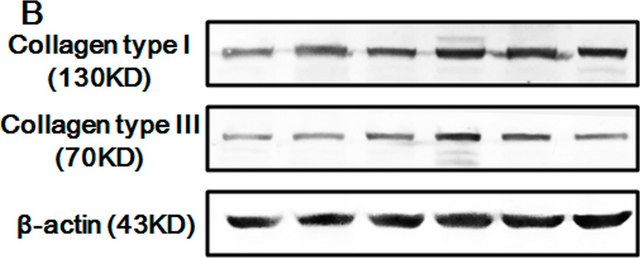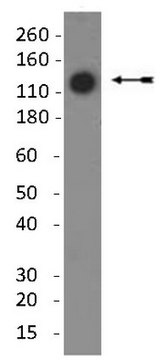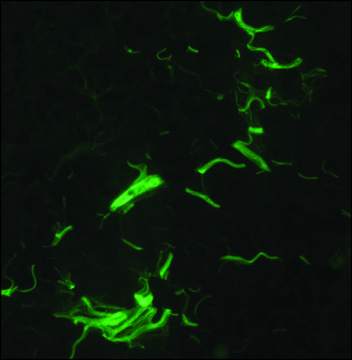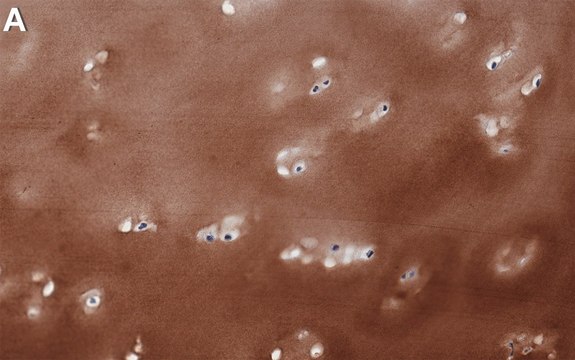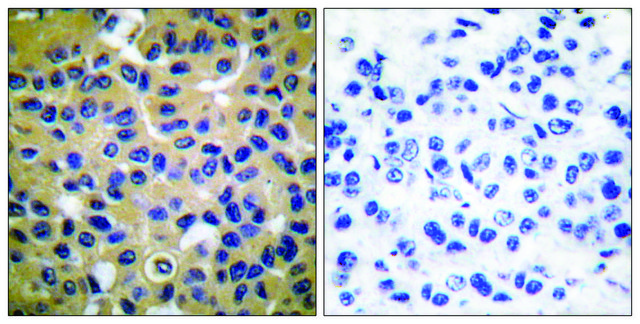推荐产品
生物来源
rabbit
抗体形式
purified immunoglobulin
抗体产品类型
primary antibodies
克隆
polyclonal
种属反应性
rat
制造商/商品名称
Chemicon®
技术
ELISA: suitable
immunohistochemistry (formalin-fixed, paraffin-embedded sections): suitable
radioimmunoassay: suitable
UniProt登记号
运输
dry ice
靶向翻译后修饰
unmodified
基因信息
rat ... Col2A1(25412)
特异性
Rat type II Collagen. The antibody shows less than 0.1% reactivity with rat Collagen Types I, III, V, rat Elastin and Fibronectin.
免疫原
Collagen Type II extracted and purified from rat fetal cartilage.
应用
Immunohistochemistry: 1:40 dilution for immunofluorescent staining of frozen rat articular cartilage tissue. The antibody is also reactive on paraffin embedded rat cartilage tissues at a dilution of 1:250 using an ABC detection system.
Radioimmunoassay
ELISA: 1:100-1:200
Optimal working dilutions must be determined by end user.
Radioimmunoassay
ELISA: 1:100-1:200
Optimal working dilutions must be determined by end user.
Research Category
Cell Structure
Cell Structure
Research Sub Category
ECM Proteins
ECM Proteins
This Anti-Collagen Type II Antibody is validated for use in ELISA, RIA, IH, IH(P) for the detection of Collagen Type II.
外形
Format: Purified
IgG fraction. Liquid at 1.0 mg/mL in 0.01M phosphate, 0.09M NaCl, pH 7.2
储存及稳定性
Maintain frozen at -20°C for up to 6 months after date of receipt. Avoid repeated freeze/thaw cycles.
法律信息
CHEMICON is a registered trademark of Merck KGaA, Darmstadt, Germany
免责声明
Unless otherwise stated in our catalog or other company documentation accompanying the product(s), our products are intended for research use only and are not to be used for any other purpose, which includes but is not limited to, unauthorized commercial uses, in vitro diagnostic uses, ex vivo or in vivo therapeutic uses or any type of consumption or application to humans or animals.
WGK
WGK 2
闪点(°F)
Not applicable
闪点(°C)
Not applicable
Yorikazu Akatsu et al.
Cell and tissue research, 375(2), 425-435 (2018-09-28)
The objectives of this study are (1) to examine age-dependent longitudinal differences in histological responses after creation of partial-thickness articular cartilage defects (PTCDs) in rats and to use this model (2) to objectively evaluate the effectiveness of interventions for cartilage
Olimpia Ortiz-Arrabal et al.
Biomedicines, 9(7) (2021-08-07)
Because cartilage has limited regenerative capability, a fully efficient advanced therapy medicinal product is needed to treat severe cartilage damage. We evaluated a novel biomaterial obtained by decellularizing sturgeon chondral endoskeleton tissue for use in cartilage tissue engineering. In silico
Li Zou et al.
Scientific reports, 6, 22868-22868 (2016-03-17)
Human pluripotent stem cells provide a standardized resource for bone repair. However, criteria to determine which exogenous cells best heal orthopedic injuries remain poorly defined. We evaluated osteogenic progenitor cells derived from both human embryonic stem cells (hESCs) and induced
David Sánchez-Porras et al.
Biomedicines, 9(3) (2021-04-04)
Considering the high prevalence of cartilage-associated pathologies, low self-repair capacity and limitations of current repair techniques, tissue engineering (TE) strategies have emerged as a promising alternative in this field. Three-dimensional culture techniques have gained attention in recent years, showing their
我们的科学家团队拥有各种研究领域经验,包括生命科学、材料科学、化学合成、色谱、分析及许多其他领域.
联系技术服务部门